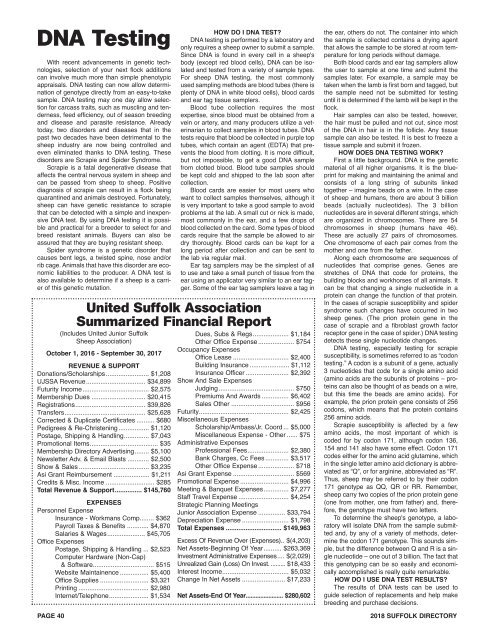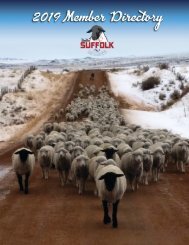2018 Suffolk Directory
Create successful ePaper yourself
Turn your PDF publications into a flip-book with our unique Google optimized e-Paper software.
DNA Testing<br />
With recent advancements in genetic technologies,<br />
selection of your next flock additions<br />
can involve much more than simple phenotypic<br />
appraisals. DNA testing can now allow determination<br />
of genotype directly from an easy-to-take<br />
sample. DNA testing may one day allow selection<br />
for carcass traits, such as muscling and tenderness,<br />
feed efficiency, out of season breeding<br />
and disease and parasite resistance. Already<br />
today, two disorders and diseases that in the<br />
past two decades have been detrimental to the<br />
sheep industry are now being controlled and<br />
even eliminated thanks to DNA testing. These<br />
disorders are Scrapie and Spider Syndrome.<br />
Scrapie is a fatal degenerative disease that<br />
affects the central nervous system in sheep and<br />
can be passed from sheep to sheep. Positive<br />
diagnosis of scrapie can result in a flock being<br />
quarantined and animals destroyed. Fortunately,<br />
sheep can have genetic resistance to scrapie<br />
that can be detected with a simple and inexpensive<br />
DNA test. By using DNA testing it is possible<br />
and practical for a breeder to select for and<br />
breed resistant animals. Buyers can also be<br />
assured that they are buying resistant sheep.<br />
Spider syndrome is a genetic disorder that<br />
causes bent legs, a twisted spine, nose and/or<br />
rib cage. Animals that have this disorder are economic<br />
liabilities to the producer. A DNA test is<br />
also available to determine if a sheep is a carrier<br />
of this genetic mutation.<br />
(Includes United Junior <strong>Suffolk</strong><br />
Sheep Association)<br />
October 1, 2016 - September 30, 2017<br />
REVENUE & SUPPORT<br />
Donations/Scholarships ........................ $1,208<br />
UJSSA Revenue................................. $34,899<br />
Futurity Income..................................... $2,575<br />
Membership Dues .............................. $20,415<br />
Registrations....................................... $39,826<br />
Transfers............................................. $25,628<br />
Corrected & Duplicate Certificates .......... $680<br />
Pedigrees & Re-Christening ................. $1,120<br />
Postage, Shipping & Handling.............. $7,043<br />
Promotional Items...................................... $35<br />
Membership <strong>Directory</strong> Advertising........ $5,100<br />
Newsletter Adv. & Email Blasts ............ $2,500<br />
Show & Sales ....................................... $3,235<br />
Asi Grant Reimbursement .................... $1,211<br />
Credits & Misc. Income ........................... $285<br />
Total Revenue & Support............... $145,760<br />
EXPENSES<br />
Personnel Expense<br />
Insurance - Workmans Comp........ $362<br />
Payroll Taxes & Benefits ............ $4,870<br />
Salaries & Wages..................... $45,705<br />
Office Expenses<br />
Postage, Shipping & Handling ... $2,523<br />
Computer Hardware (Non-Cap)<br />
& Software.................................. $515<br />
Website Maintainence ................ $5,400<br />
Office Supplies ........................... $3,321<br />
Printing ....................................... $2,980<br />
Internet/Telephone...................... $1,534<br />
PAGE 40<br />
HOw DO I DNA TEST?<br />
DNA testing is performed by a laboratory and<br />
only requires a sheep owner to submit a sample.<br />
Since DNA is found in every cell in a sheep's<br />
body (except red blood cells), DNA can be isolated<br />
and tested from a variety of sample types.<br />
For sheep DNA testing, the most commonly<br />
used sampling methods are blood tubes (there is<br />
plenty of DNA in white blood cells), blood cards<br />
and ear tag tissue samplers.<br />
Blood tube collection requires the most<br />
expertise, since blood must be obtained from a<br />
vein or artery, and many producers utilize a veterinarian<br />
to collect samples in blood tubes. DNA<br />
tests require that blood be collected in purple top<br />
tubes, which contain an agent (EDTA) that prevents<br />
the blood from clotting. It is more difficult,<br />
but not impossible, to get a good DNA sample<br />
from clotted blood. Blood tube samples should<br />
be kept cold and shipped to the lab soon after<br />
collection.<br />
Blood cards are easier for most users who<br />
want to collect samples themselves, although it<br />
is very important to take a good sample to avoid<br />
problems at the lab. A small cut or nick is made,<br />
most commonly in the ear, and a few drops of<br />
blood collected on the card. Some types of blood<br />
cards require that the sample be allowed to air<br />
dry thoroughly. Blood cards can be kept for a<br />
long period after collection and can be sent to<br />
the lab via regular mail.<br />
Ear tag samplers may be the simplest of all<br />
to use and take a small punch of tissue from the<br />
ear using an applicator very similar to an ear tagger.<br />
Some of the ear tag samplers leave a tag in<br />
United <strong>Suffolk</strong> Association<br />
Summarized Financial Report<br />
Dues, Subs & Regs.................... $1,184<br />
Other Office Expense .................... $754<br />
Occupancy Expenses<br />
Office Lease ............................... $2,400<br />
Building Insurance ...................... $1,112<br />
Insurance Officer ........................ $2,392<br />
Show And Sale Expenses<br />
Judging.......................................... $750<br />
Premiums And Awards ............... $6,402<br />
Sales Other ................................... $956<br />
Futurity.................................................. $2,425<br />
Miscellaneous Expenses<br />
Scholarship/Ambass/Jr. Coord ... $5,000<br />
Miscellaneous Expense - Other ...... $75<br />
Administrative Expenses<br />
Professional Fees....................... $2,380<br />
Bank Charges, Cc Fees ............. $3,517<br />
Other Office Expense .................... $718<br />
Asi Grant Expense .................................. $569<br />
Promotional Expense ........................... $4,996<br />
Meeting & Banquet Expenses.............. $7,277<br />
Staff Travel Expense ............................ $4,254<br />
Strategic Planning Meetings<br />
Junior Association Expense ............... $33,794<br />
Depreciation Expense .......................... $1,798<br />
Total Expenses ............................... $149,963<br />
Excess Of Revenue Over (Expenses).. $(4,203)<br />
Net Assets-Beginning Of Year.......... $263,369<br />
Investment Administrative Expenses.... $(2,029)<br />
Unrealized Gain (Loss) On Invest. ......... $18,433<br />
Interest Income..................................... $5,032<br />
Change In Net Assets ........................ $17,233<br />
Net Assets-End Of Year....................... $280,602<br />
the ear, others do not. The container into which<br />
the sample is collected contains a drying agent<br />
that allows the sample to be stored at room temperature<br />
for long periods without damage.<br />
Both blood cards and ear tag samplers allow<br />
the user to sample at one time and submit the<br />
samples later. For example, a sample may be<br />
taken when the lamb is first born and tagged, but<br />
the sample need not be submitted for testing<br />
until it is determined if the lamb will be kept in the<br />
flock.<br />
Hair samples can also be tested, however,<br />
the hair must be pulled and not cut, since most<br />
of the DNA in hair is in the follicle. Any tissue<br />
sample can also be tested. It is best to freeze a<br />
tissue sample and submit it frozen.<br />
HOw DOES DNA TESTING wORK?<br />
First a little background. DNA is the genetic<br />
material of all higher organisms. It is the blueprint<br />
for making and maintaining the animal and<br />
consists of a long string of subunits linked<br />
together – imagine beads on a wire. In the case<br />
of sheep and humans, there are about 3 billion<br />
beads (actually nucleotides). The 3 billion<br />
nucleotides are in several different strings, which<br />
are organized in chromosomes. There are 54<br />
chromosomes in sheep (humans have 46).<br />
These are actually 27 pairs of chromosomes.<br />
One chromosome of each pair comes from the<br />
mother and one from the father.<br />
Along each chromosome are sequences of<br />
nucleotides that comprise genes. Genes are<br />
stretches of DNA that code for proteins, the<br />
building blocks and workhorses of all animals. It<br />
can be that changing a single nucleotide in a<br />
protein can change the function of that protein.<br />
In the cases of scrapie susceptibility and spider<br />
syndrome such changes have occurred in two<br />
sheep genes. (The prion protein gene in the<br />
case of scrapie and a fibroblast growth factor<br />
receptor gene in the case of spider.) DNA testing<br />
detects these single nucleotide changes.<br />
DNA testing, especially testing for scrapie<br />
susceptibility, is sometimes referred to as “codon<br />
testing.” A codon is a subunit of a gene, actually<br />
3 nucleotides that code for a single amino acid<br />
(amino acids are the subunits of proteins – proteins<br />
can also be thought of as beads on a wire,<br />
but this time the beads are amino acids). For<br />
example, the prion protein gene consists of 256<br />
codons, which means that the protein contains<br />
256 amino acids.<br />
Scrapie susceptibility is affected by a few<br />
amino acids, the most important of which is<br />
coded for by codon 171, although codon 136,<br />
154 and 141 also have some effect. Codon 171<br />
codes either for the amino acid glutamine, which<br />
in the single letter amino acid dictionary is abbreviated<br />
as “Q”, or for arginine, abbreviated as “R”.<br />
Thus, sheep may be referred to by their codon<br />
171 genotype as QQ, QR or RR. Remember,<br />
sheep carry two copies of the prion protein gene<br />
(one from mother, one from father) and, therefore,<br />
the genotype must have two letters.<br />
To determine the sheep's genotype, a laboratory<br />
will isolate DNA from the sample submitted<br />
and, by any of a variety of methods, determine<br />
the codon 171 genotype. This sounds simple,<br />
but the difference between Q and R is a single<br />
nucleotide – one out of 3 billion. The fact that<br />
this genotyping can be so easily and economically<br />
accomplished is really quite remarkable.<br />
HOw DO I USE DNA TEST RESULTS?<br />
The results of DNA tests can be used to<br />
guide selection of replacements and help make<br />
breeding and purchase decisions.<br />
<strong>2018</strong> SUFFOLK DIRECTORY





